Rennie Scaysbrook | November 15, 2018
Starting Fresh
With a clean sheet of paper, BMW is putting some new charge back into their trusty middleweight adventure steed. Say hello to the BMW F 750 GS.
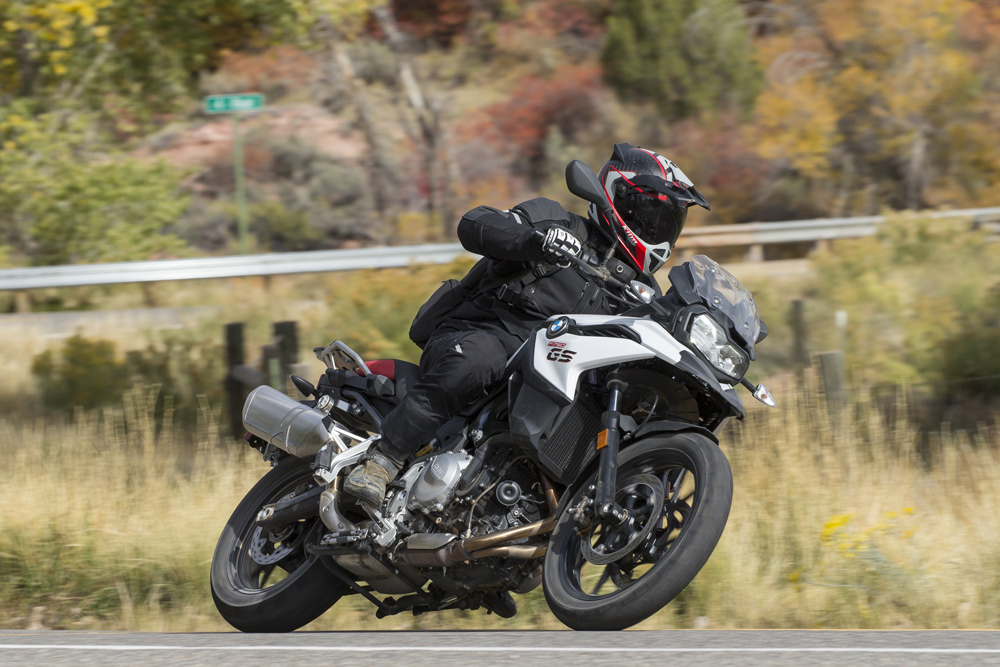 Tarmac is where the 750 GS shines but you can get a few jollies on dirt roads as well. Just not too many.
Tarmac is where the 750 GS shines but you can get a few jollies on dirt roads as well. Just not too many.
BMW Motorrad’s GS line is its most prized possession. Those two letters of G and S are what saved BMW Motorrad from oblivion in the early 1980s with the introduction of the R80G/S, going on to spawn not just a new line of motorcycles but an entirely new riding culture of grand adventuring.

Photography by Kevin Wing
The GS line is now seven motorcycles strong, starting with the baby G 310 GS and ending with the granddaddy R 1250 GS Adventure. Nestled nicely in between this is the bike formerly known as the F 700, growing by 50 to be now known as the F 750 GS.
Like the recently revamped 1250 GS, it’s more than just a name change for the middleweight road/adventure steed. The F 750 GS has been redesigned for the first time in 10 years, with an all-new engine, a new chassis and suspension, new electronics and a huge TFT dash display that’s one of the coolest items on the market today.
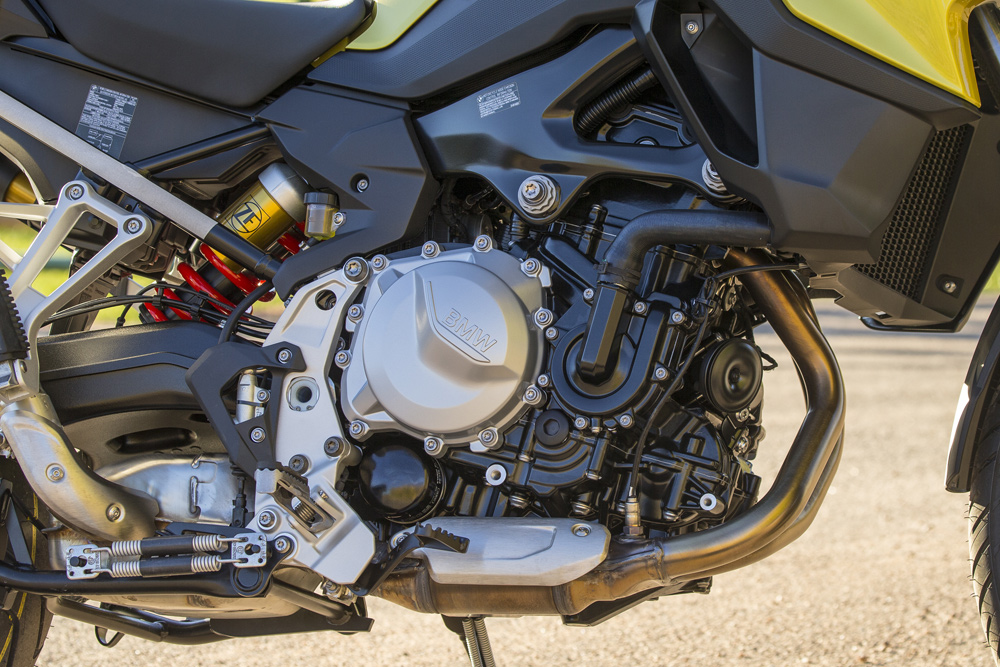 New motor through and through. It’s remarkably smooth for a parallel-twin thanks to the twin counterbalancers.
New motor through and through. It’s remarkably smooth for a parallel-twin thanks to the twin counterbalancers.
A New Heart
The liquid-cooled, DOHC, eight-valve, four-stroke engine powering the F 750 GS is a ground-up redesign, with BMW claiming 77 horsepower at 7500 rpm and 61 lb-ft of torque at 6000 rpm, via the 853cc engine that’s both longer and wider at 84 x 77mm bore and stroke compared to the 92 x 75.6mm dimension of the 700.
BMW engineers were charged with not only improving horsepower and reducing fuel consumption, but also reducing the vibrations felt by the rider at speed. To this end, they’ve fitted a second counterbalancer and changed the crankpin offset from 0° to 90° to give a 270°/450° firing interval and with it, an all-new, deeper exhaust note compared to the 0°/360° firing intervals of the old 798cc F 700 GS.
That F 700 was fitted with a single connecting rod between the two main rods to dampen out vibrations, but the 850 gets two dedicated counterbalancers mounted on the crankshaft and driven by spur gears. The result is one of the smoothest twin-cylinder motors I’ve ever ridden, one who’s throttle response can be manipulated up to four different ways by the two standard ride modes of Rain and Road, and two optional extra modes of Dynamic and Enduro (the F 850 GS also gets an another mode of Enduro Pro).
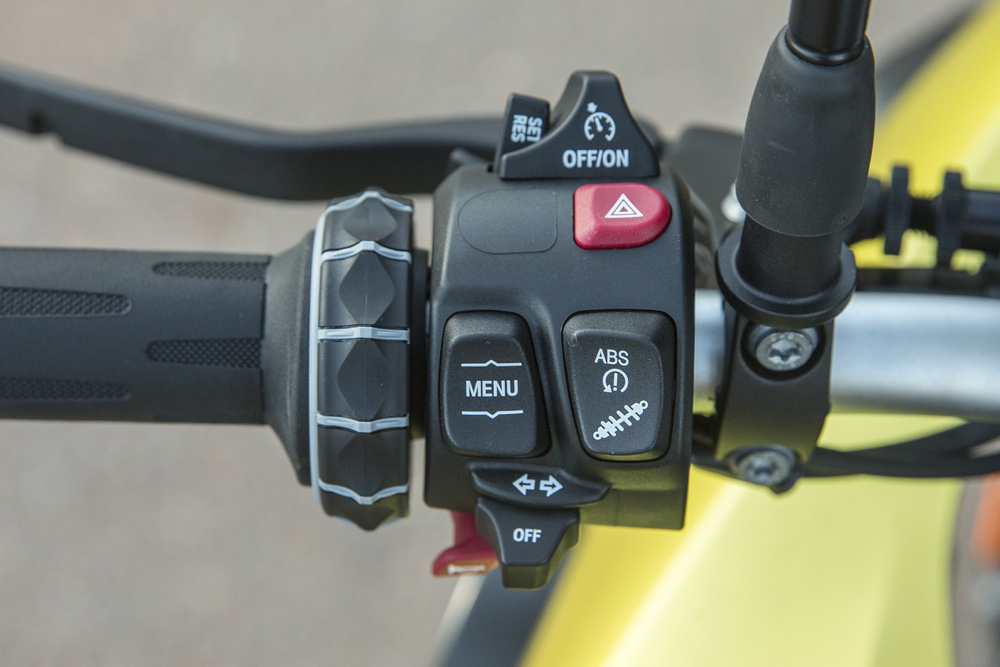 Mission control for all the electronic gizmos on the 750. It’s been this way for years with BMW motorcycles.
Mission control for all the electronic gizmos on the 750. It’s been this way for years with BMW motorcycles.
Getting that go to the chain drive that’s been moved from right to left is a redesigned six-speed gearbox that can be fitted with BMW’s Gear Shift Assist Pro for clutchless up and down shifts as a factory accessory. The clutch is new, BMW fitting an anti-hopping (slipper) design so you can bang down the gears and not lock the back wheel up—the design also helps to give a lighter pull at the lever than previously.
With the chain drive moved to the left, the exhaust has been relocated to the right, and the gas tank, which was normally found at the rear of the bike under the seat has been moved back to the traditional place of behind the steering head. This is one of the more easily spotted improvements made to the chassis design, as the top of the tank is now taller than the outgoing 700, and the back-end of the motorcycle dramatically slimmer.
 Moving the gas tank to the traditional place behind the steering head has freed up the rear of the bike substantially.
Moving the gas tank to the traditional place behind the steering head has freed up the rear of the bike substantially.
The chassis has been thoroughly redesigned and features the engine as a stressed member in a monocoque format, compared to the tubular steel spaceframe of the 700, giving the 750 greater torsional rigidity and better handling. The fork is a traditional 41mm telescopic unit that’s not adjustable, with 5.9 inches of travel in the standard setting and 5.2 inches when lowered, and 6.9/6.2 inches for the shock. That’s one of the biggest things BMW wants to get across to riders with the new 750—the ease at which you can make this bike fit your frame.
There’re three different seat options and the ability to fit the lower suspension. The latter, when fitted with the low-seat option, gives a seat height of 30.3 inches. BMW is going hard after female riders and guys with shorter inseams with the F 750 GS, giving them that plethora of choice when it comes to getting the bike fitted correctly.
The electronics are as you’d expect from BMW. Traction control and ABS come as standard, and you can fit the Dynamic ESA (electronic suspension adjustment) as a factory extra for the rear suspension only (front remains non-adjustable). You can also fit ABS Pro as an extra, which is essentially BMW’s Cornering ABS system to allow you to crank the front brake on while leaned over at speed and continue around the bend without the bike standing up.
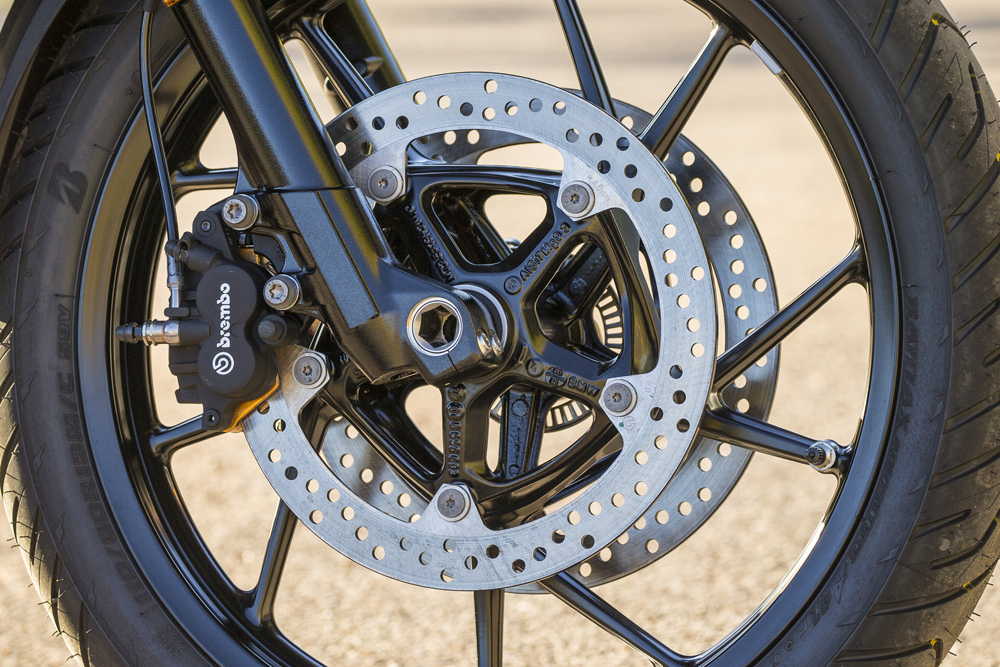 Brakes are pretty small, as are the fork legs. That alloy rim doesn’t like hitting things hard at speed, either, and can dent easily.
Brakes are pretty small, as are the fork legs. That alloy rim doesn’t like hitting things hard at speed, either, and can dent easily.
The bodywork has been cut and shut, giving a more angular appearance, you also get LED lighting front and rear and you don’t have to stick your key in the ignition anymore thanks to BMW’s Keyless Ride wireless link.
By far one of the most impressive features is the new 6.5-inch TFT display dash. This is more than just a nice display and allows you to pair your phone (standard practice nowadays)/use navigation to the bike, but also use the BMW Motorrad Connected App that’s been developed with Colorado startup REVER. This will allow you to track your riding route, create riding maps, and share them with your riding buddies.
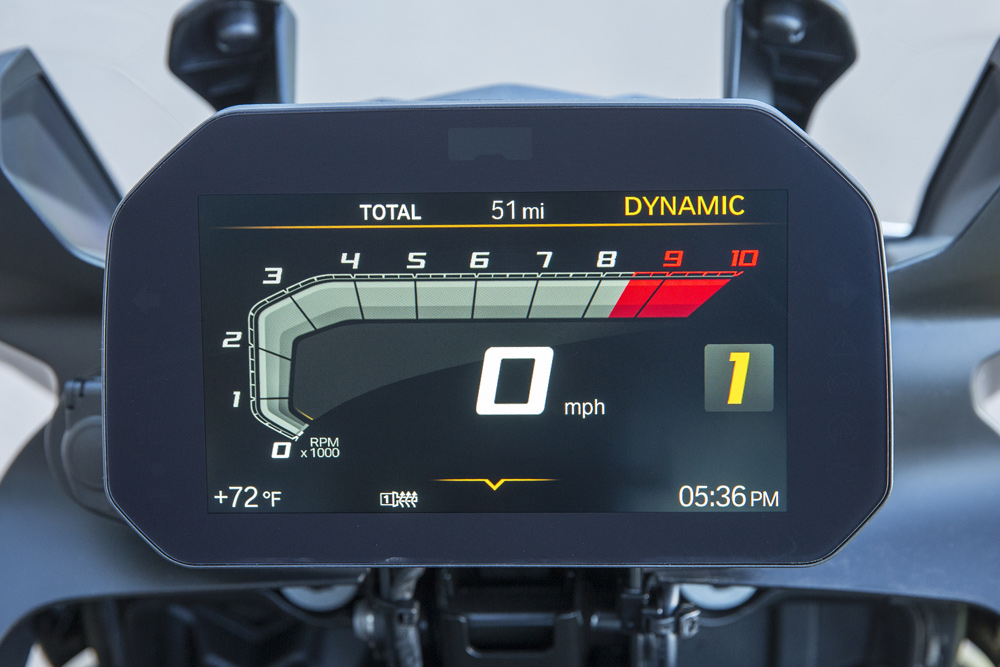 The new dash is superb and offers an absolute plethora of options for the rider.
The new dash is superb and offers an absolute plethora of options for the rider.
From the Hot Seat
The chance to sample the fruits of BMW’s near-10-year development program with the F 750 GS came at the national introduction ride in Utah recently. It was a short day on the 750, with us covering about 120 miles of backcountry dirt roads and tarmac twisties, and, at the conclusion, two points really stood out.
The first is that the 750 makes for an excellent street bike. The work BMW has put into that engine makes for one of the smoothest rides on the market today, thanks to the twin counterbalancers now fitted to the parallel-twin. The initial throttle response is silky smooth—almost uninspiring—simply because it picks up torque so effortlessly. The 853cc engine doesn’t have huge amounts of power, but what is there is easily manageable and matched to gear ratios that allow you to either max out individual gears or simply lug along from corner to corner with the revs never seeing north of 5000.
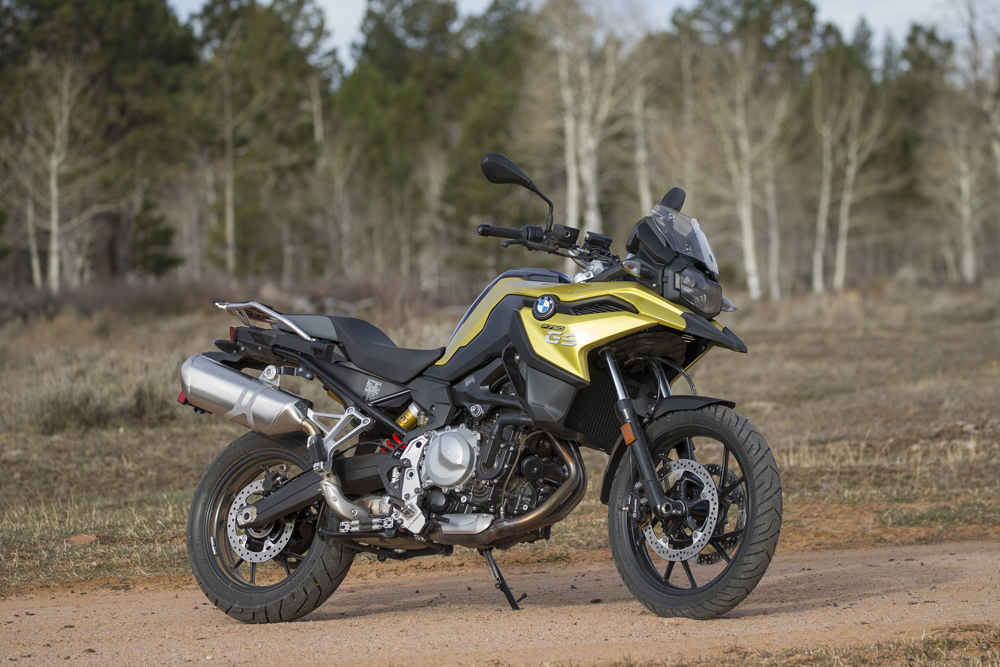 Who remembers the Austin Yellow Metallic color from the first S 1000 RR of 2010?
Who remembers the Austin Yellow Metallic color from the first S 1000 RR of 2010?
Our test bike was fitted with the optional Gear Shift Assist Pro, which is one of the best quickshift systems available. It makes for such buttery smooth gearshifts, although it doesn’t love shifting back through the gears if the revs are below 1500.
The ride position is ideal for the street. The bar and peg placement is a little tight for my 6’1” frame but after our little ride I could easily have done that distance again with no drama. Braking via the ABS-equipped system is good without being outstanding—there’s enough power to haul you down from most speeds but really start to push the system hard and you’ll begin to get a tough of fade at the lever—something no span-adjustable lever can dial out.
On road and at sensible speeds, the suspension is near faultless. Although the front is non-adjustable and the rear only has preload, the chassis remains poised in corners and the ride is extremely comfortable.
But this street factor is one of the reasons the F 750 GS is not going to cut it on anything other than relatively smooth dirt roads in the adventure department. Take the 750 off road and the ergonomics of the ride become a hindrance. The bar position and bend are too close to the rider, the tiny footpegs and ultra-soft suspension make you second guess riding over anything that isn’t a speed bump, and the fitment of Bridgestone A41 tires—while still a decent dirt road tire—will make you become a lot more cautious than with proper knobby tires.
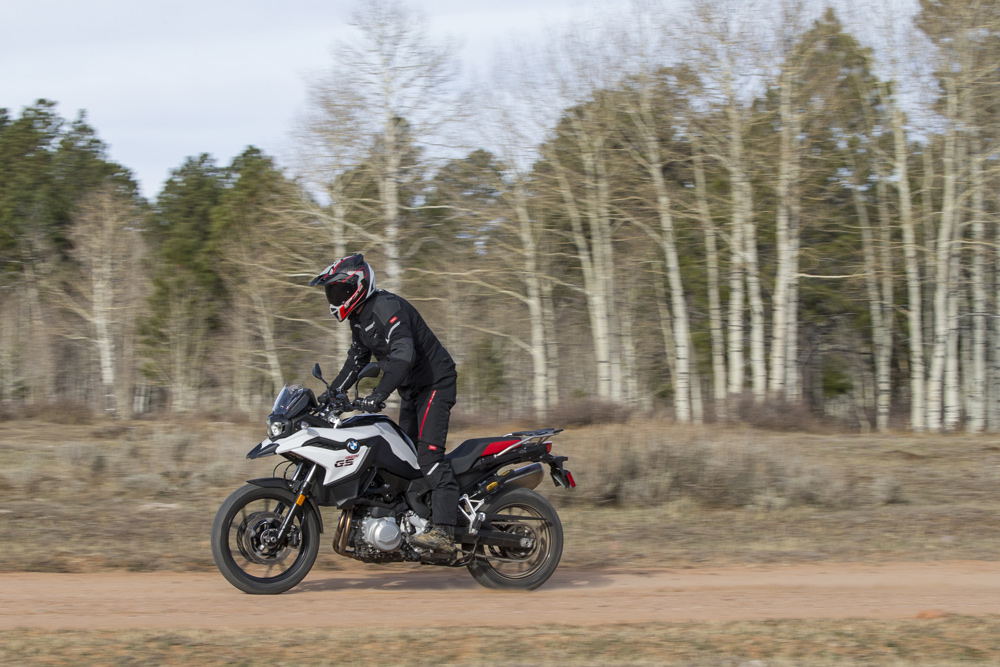 This is about as hard an off-road trail as you’ll want to take the 750.
This is about as hard an off-road trail as you’ll want to take the 750.
These are issues that can largely be fixed with new handlebars, tires, and a different seat, but in standard form, the 750 is not very confidence-inspiring in the dirt. Hopefully, this won’t put first time ADV riders off hitting the dirt too much and might even allow them to whet their appetite enough to invest in a real ADV machine, like the F 850 GS we tested later.
To keep the 750 in the happy zone, stick primarily to the tarmac. This is where the motorcycle shines the best, and will provide and excellent platform for big-mile days.CN
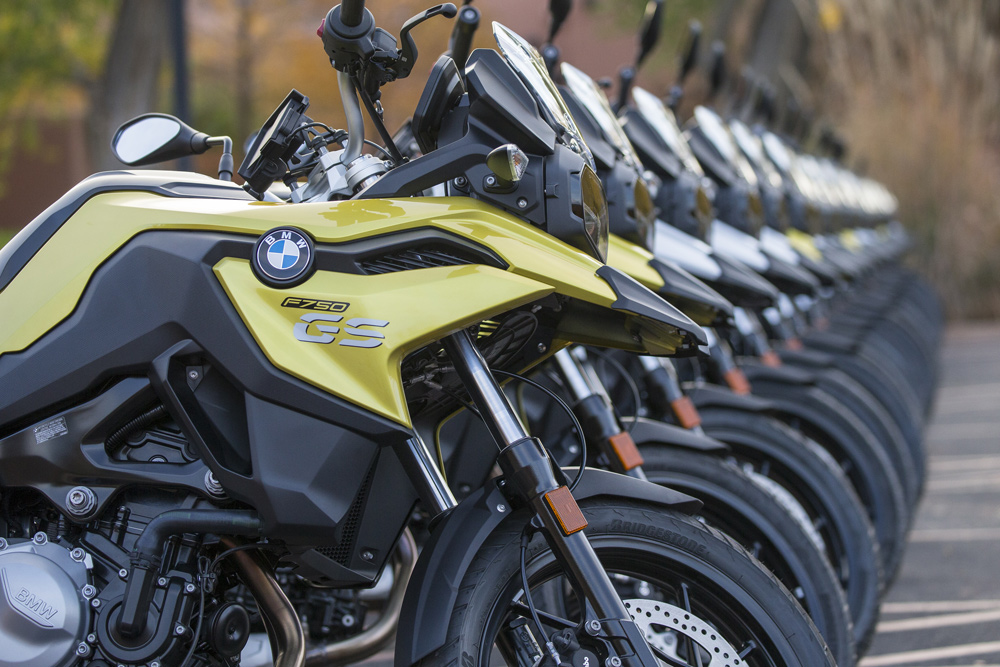 You want accessories for your F 750 GS? BMW’s got ’em.
You want accessories for your F 750 GS? BMW’s got ’em.
Making it Yours
BMW’s famous for giving you plenty of options when it comes to customizing your ride and there’s far more accessories for the 700 than we can list here (60-percent more stuff than last year), but they’ve given you a start with the base optional equipment and the Select and Premium package. Each of these adds a fair bit to the MSRP that can be altered depending on what you buy, so consult with your BMW dealer as to exactly what each package will cost you.
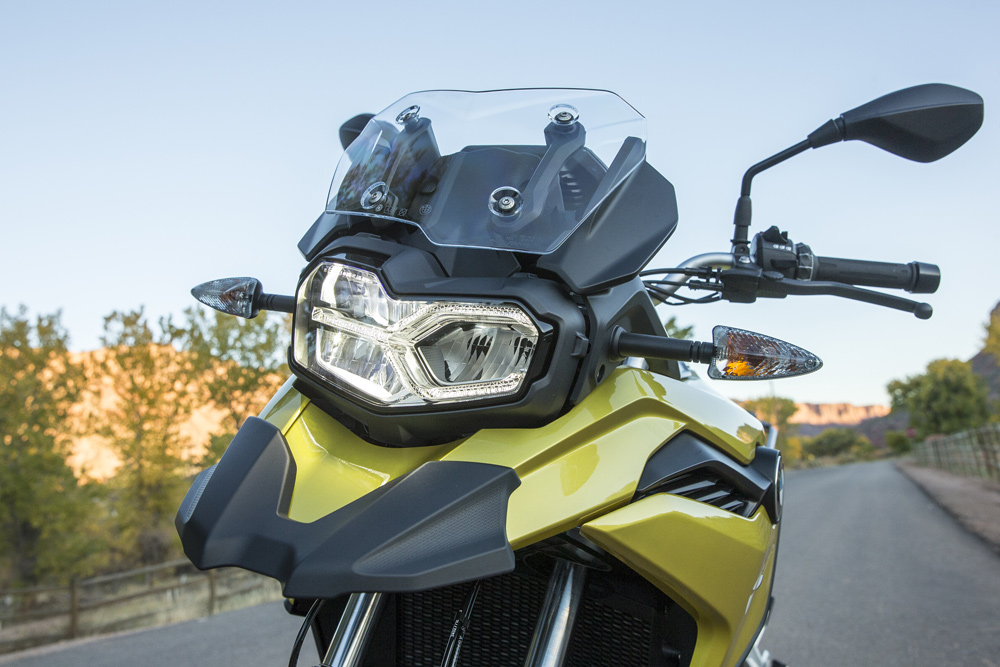 LED headlight and taillight abounds with the 750.
LED headlight and taillight abounds with the 750.
The good news is ASC (Automatic Stability Control), LED headlights, onboard computer, and adjustable rear brake and gear shift levers are now standard fitment, whereas before they’d have cost you yet more dollars.
Optional Equipment
- Lowered suspension.
- Seat bench for two, low.
- Comfort seat.
- HP Sport Exhaust
- Off-road tires (only F 850 GS).
- Centerstand.
- Alarm system.
Select Package
- Heated grips.
- Cruise control.
- Luggage rack with saddlebag mounts.
- Connectivity incl. 6.5 inch TFT color display.
- Ride modes Pro including DTC, ABS Pro
- Gear-shift assist Pro.
Premium Package
Includes all the equipment in the Select Package, plus:
- LED Style Element.
- Keyless Ride.
- Tire-Pressure Monitor
- Dynamic Electronic Suspension Adjustment (ESA) or Low Suspension
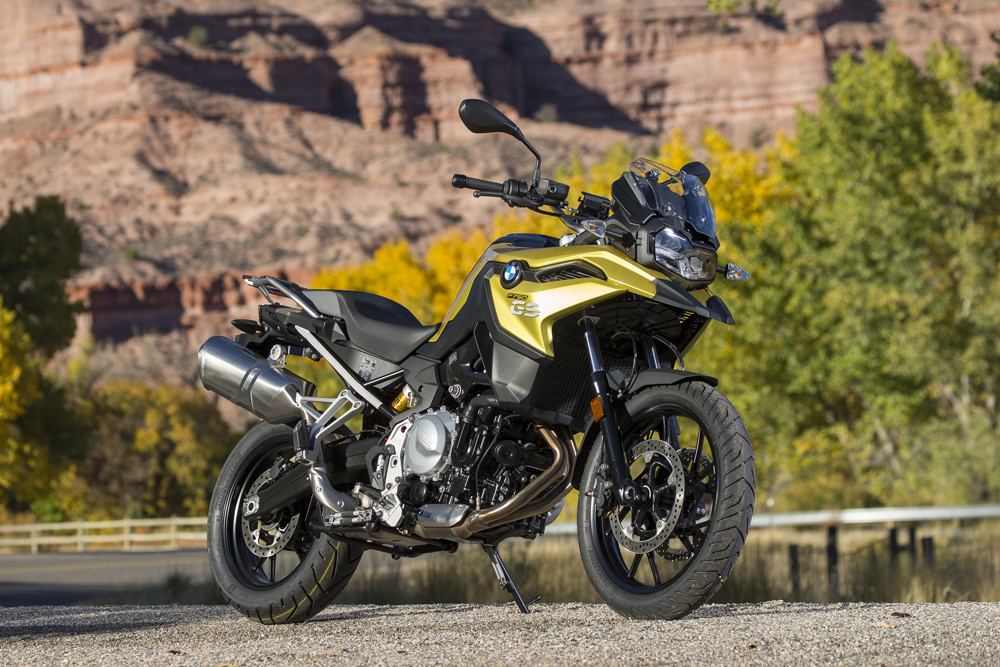
| SPECIFICATIONS |
2019 BMW F 750 GS ($10,395) |
| Engine: |
Liquid-cooled, DOHC, 4-stroke, Parallel-twin |
| Displacement: |
853cc |
| Bore x stroke: |
84 x 77mm |
| Compression ratio: |
12.7:1 |
| Clutch: |
Wet multi-plate |
| Transmission: |
6-speed |
| Chassis: |
Steel monocoque |
| Front suspension: |
41mm conventional fork, non-adjustable |
| Rear suspension: |
Monoshock, preload adjustable |
| Front wheel travel: |
5.9 in. |
| Rear wheel travel: |
6.9 in. |
| Front brake: |
2 x 305mm disc, 2-piston calipers, ABS |
| Rear brake: |
265mm disc, 1-piston, floating caliper, ABS |
| Front tire: |
110/80 R19 in. |
| Rear tire: |
150/70 R17 in. |
| Wheelbase: |
61.4 in. |
| Seat height: |
32.1 in. |
| Fuel capacity: |
4 gal. |
| Weight (dry, claimed): |
493 lbs. |
| Colors: |
Stereo Metallic Matte, Light White, Austin Yellow Metallic |